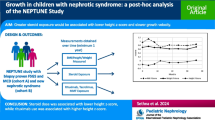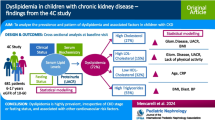Abstract
Background
Cardiovascular (CV) risk is high in children with chronic kidney disease (CKD), and further compounded in those who are overweight. Children with CKD have a unique body habitus not accurately assessed by body mass index (BMI). Waist-to-height ratio (WHr), a better predictor of CV risk in populations with short stature, has not been investigated in children with CKD.
Methods
Analysis of 1723 visits of 593 participants enrolled in the Chronic Kidney Disease in Children (CKiD) study was conducted. CKiD participants had BMI and WHr measured and classified as follows: (1) lean (WHr ≤ 0.49, BMI < 85th percentile); (2) WHr-overweight (WHr > 0.49, BMI < 85th percentile); (3) BMI-overweight (WHr ≤ 0.49, BMI ≥ 85th percentile); or (4) overweight by both BMI and WHr. Left ventricular mass index (LVMI), fasting lipids, fibroblast growth factor 23 (FGF23), blood pressure, and glucose were measured as markers of CV risk. Linear mixed-effects regression was used to evaluate differences in CV markers between overweight and lean groups.
Results
Participants were 12.2 years old, 60% male, and 17% African-American. Approximately 15% were overweight by WHr but not by BMI. Overweight status by WHr-only or both WHr and BMI was associated with lower high-density lipoprotein (HDL) and higher LVMI, triglycerides, and non-HDL cholesterol compared to lean. CV markers of participants overweight by BMI-only were similar to those of lean children.
Conclusions
WHr-adiposity is associated with an adverse CV risk profile in children with CKD. A significant proportion of children with central adiposity are missed by BMI. WHr should be utilized as a screening tool for CV risk in this population.


Similar content being viewed by others
References
Mitsnefes MM, Laskin BL, Dahhou M, Zhang X, Foster BJ (2013) Mortality risk among children initially treated with dialysis for end-stage kidney disease, 1990–2010. JAMA 309:1921–1929
Elffers TW, de Mutsert R, Lamb HJ, de Roos A, Willems van Dijk K, Rosendaal FR, Jukema JW, Trompet S (2017) Body fat distribution, in particular visceral fat, is associated with cardiometabolic risk factors in obese women. PLoS One 12:e0185403
Caprio S, Hyman LD, McCarthy S, Lange R, Bronson M, Tamborlane WV (1996) Fat distribution and cardiovascular risk factors in obese adolescent girls: importance of the intraabdominal fat depot. Am J Clin Nutr 64:12–17
Kahn HS, Imperatore G, Cheng YJ (2005) A population-based comparison of BMI percentiles and waist-to-height ratio for identifying cardiovascular risk in youth. J Pediatr 146:482–488
Weber DR, Leonard MB, Zemel BS (2012) Body composition analysis in the pediatric population. Pediatr Endocrinol Rev 10:130–139
Javed A, Jumean M, Murad MH, Okorodudu D, Kumar S, Somers VK, Sochor O, Lopez-Jimenez F (2015) Diagnostic performance of body mass index to identify obesity as defined by body adiposity in children and adolescents: a systematic review and meta-analysis. Pediatr Obes 10:234–244
Khoury M, Manlhiot C, McCrindle BW (2013) Role of the waist/height ratio in the cardiometabolic risk assessment of children classified by body mass index. J Am Coll Cardiol 62:742–751
Maffeis C, Banzato C, Talamini G (2008) Waist-to-height ratio, a useful index to identify high metabolic risk in overweight children. J Pediatr 152:207–213
Mombelli G, Zanaboni AM, Gaito S, Sirtori CR (2009) Waist-to-height ratio is a highly sensitive index for the metabolic syndrome in a Mediterranean population. Metab Syndr Relat Disord 7:477–484
Lo K, Wong M, Khalechelvam P, Tam W (2016) Waist-to-height ratio, body mass index and waist circumference for screening paediatric cardio-metabolic risk factors: a meta-analysis. Obes Rev 17:1258–1275
Savva SC, Tornaritis M, Savva ME, Kourides Y, Panagi A, Silikiotou N, Georgiou C, Kafatos A (2000) Waist circumference and waist-to-height ratio are better predictors of cardiovascular disease risk factors in children than body mass index. Int J Obes Relat Metab Disord 24:1453–1458
Rodig NM, McDermott KC, Schneider MF, Hotchkiss HM, Yadin O, Seikaly MG, Furth SL, Warady BA (2014) Growth in children with chronic kidney disease: a report from the Chronic Kidney Disease in Children Study. Pediatr Nephrol 29:1987–1995
Johnson VL, Wang J, Kaskel FJ, Pierson RN (2000) Changes in body composition of children with chronic renal failure on growth hormone. Pediatr Nephrol 14:695–700
Rashid R, Neill E, Smith W, King D, Beattie TJ, Murphy A, Ramage IJ, Maxwell H, Ahmed SF (2006) Body composition and nutritional intake in children with chronic kidney disease. Pediatr Nephrol 21:1730–1738
Furth SL, Cole SR, Moxey-Mims M, Kaskel F, Mak R, Schwartz G, Wong C, Munoz A, Warady BA (2006) Design and methods of the Chronic Kidney Disease in Children (CKiD) prospective cohort study. Clin J Am Soc Nephrol 1:1006–1015
Ogden CL, Kuczmarski RJ, Flegal KM, Mei Z, Guo S, Wei R, Grummer-Strawn LM, Curtin LR, Roche AF, Johnson CL (2002) Centers for Disease Control and Prevention 2000 growth charts for the United States: improvements to the 1977 National Center for Health Statistics version. Pediatrics 109:45–60
(2004) The fourth report on the diagnosis, evaluation, and treatment of high blood pressure in children and adolescents. Pediatrics 114:555–576
Schwartz GJ, Schneider MF, Maier PS, Moxey-Mims M, Dharnidharka VR, Warady BA, Furth SL, Munoz A (2012) Improved equations estimating GFR in children with chronic kidney disease using an immunonephelometric determination of cystatin C. Kidney Int 82:445–453
Massa F, Garbay S, Bouvier R, Sugitani Y, Noda T, Gubler MC, Heidet L, Pontoglio M, Fischer E (2013) Hepatocyte nuclear factor 1beta controls nephron tubular development. Development 140:886–896
Mehta SK (2016) Waist circumference to height ratio and left ventricular mass in children and adolescents. Cardiol Young 26:658–662
Frayn KN (2002) Adipose tissue as a buffer for daily lipid flux. Diabetologia 45:1201–1210
de Ferranti S, Mozaffarian D (2008) The perfect storm: obesity, adipocyte dysfunction, and metabolic consequences. Clin Chem 54:945–955
Iacobellis G, Assael F, Ribaudo MC, Zappaterreno A, Alessi G, Di Mario U, Leonetti F (2003) Epicardial fat from echocardiography: a new method for visceral adipose tissue prediction. Obes Res 11:304–310
Kankaanpaa M, Lehto HR, Parkka JP, Komu M, Viljanen A, Ferrannini E, Knuuti J, Nuutila P, Parkkola R, Iozzo P (2006) Myocardial triglyceride content and epicardial fat mass in human obesity: relationship to left ventricular function and serum free fatty acid levels. J Clin Endocrinol Metab 91:4689–4695
Zhou YT, Grayburn P, Karim A, Shimabukuro M, Higa M, Baetens D, Orci L, Unger RH (2000) Lipotoxic heart disease in obese rats: implications for human obesity. Proc Natl Acad Sci U S A 97:1784–1789
Ho SY, Lam TH, Janus ED (2003) Waist to stature ratio is more strongly associated with cardiovascular risk factors than other simple anthropometric indices. Ann Epidemiol 13:683–691
Diemer FS, Brewster LM, Haan YC, Oehlers GP, van Montfrans GA, Nahar-van Venrooij LMW (2017) Body composition measures and cardiovascular risk in high-risk ethnic groups. Clin Nutr. https://doi.org/10.1016/j.clnu.2017.11.012
Patel HP, Saland JM, Ng DK, Jiang S, Warady BA, Furth SL, Flynn JT (2017) Waist circumference and body mass index in children with chronic kidney disease and metabolic, cardiovascular, and renal outcomes. J Pediatr 191:133–139
Hu X, Ma X, Luo Y, Xu Y, Xiong Q, Pan X, Xiao Y, Bao Y, Jia W (2016) Associations of serum fibroblast growth factor 23 levels with obesity and visceral fat accumulation. Clin Nutr 37:223–228
Mitsnefes MM, Betoko A, Schneider MF, Salusky IB, Wolf MS, Juppner H, Warady BA, Furth SL, Portale AA (2018) FGF23 and left ventricular hypertrophy in children with CKD. Clin J Am Soc Nephrol 13:45–52
Faul C, Amaral AP, Oskouei B, Hu MC, Sloan A, Isakova T, Gutierrez OM, Aguillon-Prada R, Lincoln J, Hare JM, Mundel P, Morales A, Scialla J, Fischer M, Soliman EZ, Chen J, Go AS, Rosas SE, Nessel L, Townsend RR, Feldman HI, St John Sutton M, Ojo A, Gadegbeku C, Di Marco GS, Reuter S, Kentrup D, Tiemann K, Brand M, Hill JA, Moe OW, Kuro OM, Kusek JW, Keane MG, Wolf M (2011) FGF23 induces left ventricular hypertrophy. J Clin Invest 121:4393–4408
Acknowledgements
Data in this manuscript were collected by the Chronic Kidney Disease in Children prospective cohort study (CKiD) with the clinical coordinating centers (Principal Investigators) at Children’s Mercy Hospital and the University of Missouri – Kansas City (Bradley Warady, MD) and Children’s Hospital of Philadelphia (Susan Furth, MD, PhD), Central Biochemistry Laboratory (George Schwartz, MD) at the University of Rochester Medical Center, and data coordinating center (Alvaro Muñoz, PhD) at the Johns Hopkins Bloomberg School of Public Health.
Funding
The CKiD Study is supported by grants from the National Institute of Diabetes and Digestive and Kidney Diseases, with additional funding from the Eunice Kennedy Shriver National Institute of Child Health and Human Development, and the National Heart, Lung, and Blood Institute (U01-DK-66143, U01-DK-66174, U01DK-082194, U01-DK-66116). The CKiD website is located at http://www.statepi.jhsph.edu/ckid.
Author information
Authors and Affiliations
Contributions
All authors contributed to the conception or design of the study, analysis, and/or interpretation of data, writing, and/or revising the manuscript. All authors contributed to the intellectual contents of this work.
Corresponding author
Ethics declarations
Conflict of interest
The authors declare that they have no conflict of interest.
Rights and permissions
About this article
Cite this article
Sgambat, K., Roem, J., Mitsnefes, M. et al. Waist-to-height ratio, body mass index, and cardiovascular risk profile in children with chronic kidney disease. Pediatr Nephrol 33, 1577–1583 (2018). https://doi.org/10.1007/s00467-018-3987-2
Received:
Revised:
Accepted:
Published:
Issue Date:
DOI: https://doi.org/10.1007/s00467-018-3987-2




